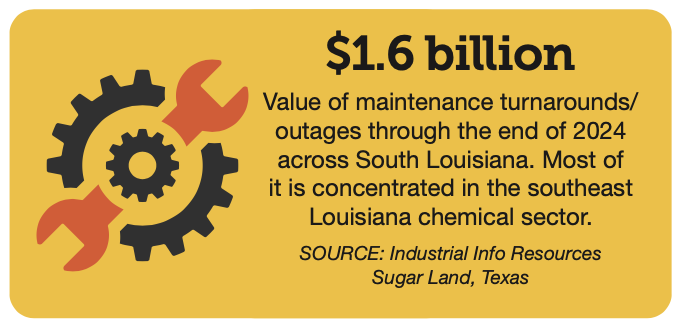A significant uptick in maintenance turnarounds is most definitely on the way, beginning this spring then followed by a much larger splash in October.
From a workforce perspective, it couldn’t come at a worse time. The labor forces of many industrial contractors are already maxed out and it could get a lot worse should expected capital projects crank up at the same time later this year and into 2024.
Of all of Louisiana’s metro areas, the greater Baton Rouge area has the largest volume of work about to break ground. Loren Scott, economist at Loren C. Scott & Associates in Baton Rouge, expects a spike of about 8,000 industrial workers, largely due to several impending capital projects in the chemicals and renewables sector, such as Grön Fuels in Port Allen and the retrofit of the Shell plant in Convent. Says Scott: “Baton Rouge has a host of capital projects with a 60 percent probability of breaking ground.”

At the same time, Industrial Info Resources of Sugar Land, Texas, is tracking some $1.6 billion in maintenance turnarounds/outages through the end of 2024 across South Louisiana, the bulk of which to be concentrated in the southeast Louisiana chemical sector. The reason? Consistently high rates of utilization, says Trey Hamblet, vice president of chemicals research for IIR. “They’re operating all available shifts and running at full tilt,” he adds. “Of course, when you’re running a plant at that pace it requires maintenance.
“There’s been a very consistent increase in both spend and activity in the chemical sector, year over year, for quite a long time,” he adds. “Other than a little bit of a fallback in 2020, we’ve seen nothing but a continued climb in maintenance for many years now.”
The maintenance surge is expected to peak this September and October with some $174 million in turnaround expenditures in South Louisiana, the most significant of which at Dow Chemical’s St. Charles plant (hydrocarbon unit), Indorama Ventures in Lake Charles (olefins plant), Shell Norco (delayed coker unit), Dyno Nobel Inc. in Westwego (anhydrous ammonia plant), and Tokai Carbon CB Ltd. in Addis (carbon black).
Hamblet says the refining industry will also have a “pretty heavy spring and fall” due to turnarounds that have been pushed for two or more years. When demand for fuel and refining products surged back to pre-pandemic levels in 2021-22, refiners postponed maintenance to keep up with the need. As a result, he says there are “a dozen or so” refinery units with planned turnarounds that were postponed from a couple of years ago. As a workaround, some owners are choosing to push turnarounds to the summer “off-cycle” to balance the load.
Fred McManus, COO at Brown & Root in Baton Rouge, has seen a 20% to 25% uptick in turnaround work since the pandemic, and it’s holding steady. Most of their Louisiana work stretches from just north of Baton Rouge to New Orleans, with and increasing number of clients in the southwest part of the state. “The turnaround workload has been put off for the last few years, and we’re starting to see that come to fruition,” McManus says. “For that reason, our workload has been higher than in the previous three years.”

Brown & Root’s head count is up by about 10% to 15% over last year. Currently, the contractor averages about 9,000 employees, 3,500 of which are in Louisiana, with another 2,000 to 3,000 in Texas and the remainder across 25 other states. “I was a little concerned whether we were going to be able to get the people we needed, but we seem to be holding our own,” he adds. “Our spring outage season (January through April) is going to be one of our best.”
Of course, the industrial surge will be good news for the Louisiana economy. “Southeast Texas and south Louisiana are going to be unique in terms of having a lot of industrial expansion work that will continue through any national recession,” Scott says. “As a result, we forecast that Louisiana’s economy will grow right through the recession.”
There’s also some good news on the supply side of the equation. “About the time we need those workers, you’re going to find a lot of people starting to look for work,” he adds. “People don’t appreciate the impact of the stimulus checks. When you look at savings rate in the U.S., it increased above its trend by $3 trillion. It was a monstrous increase. As a result, a lot of people decided to stay at home and live off the money. That has been whittled down to $1 trillion, so people will be looking for work.”
Additionally, most forecasts indicate that a national recession will occur by the second half of 2023. “It’s not going to be a very deep and long recession, but it will be significant enough that people will lose their jobs. They’re going to be looking for a place to find work, and south Louisiana is going to be a hot spot.”
GETTING READY
David Helveston, president and CEO of Associated Builders and Contractors’ Pelican Chapter, says many of his members are already at full employment, and a presumed influx of work would make it difficult for them to find the qualified workers they’ll need. Helveston meets with the Industrial Contractors Council once a month to gauge future needs. “They expect the labor market to tighten significantly over the next year as many of these projects get under way,” he says.
McManus says Brown & Root’s priority has been finding an adequate number of millwrights, combination welders and heavy equipment operators. “I make sure that when we book work that I know for certain that I can get those resources,” he adds. “That’s where we focus our training dollars.”

Of course, a surge in worker demand will likely come with a corresponding escalation in worker wages. Brown & Root relies upon Alpha Resources, a Birmingham-based human resources consultant that provides “point-in-time” craft compensation data to keep up with going wage rates and per diems.
Scott Barringer, president and CEO at PALA Group in Baton Rouge, expects wage rates to increase as projects are released and contractors compete for the same small group of workers. “Ironically, we currently have more workers leaving the state for work than we have coming to Louisiana,” he adds. “Construction workers go where the opportunities are and where they can make the most money.”
Glen J. Gulino, executive vice president of ISC Constructors LLC in Baton Rouge, says his company’s executive team has been discussing the best steps for preparing for the influx. “We feel most of the heavy lifting will take place in 2024, 2025 and 202,” Gulino says. “That will be sustained as these projects continue.”
ISC currently maintains a workforce of some 1,200 to 1,600 craftspeople, and during cyclical maintenance cycles they’ll bring in another 50 to 300 employees to support maintenance turnarounds.
Fortunately, ISC hasn’t had to turn down work due to a lack of manpower, although Gulino says that time could come. “We can’t take our eye off the ball,” he adds. “When we start getting these wage and compensation pressures, our biggest priority is ensuring that our associates are properly compensated and have good benefits to keep them from going elsewhere.”
They currently benefit from a “steady supply” of trainees being funneled through the ABC training program. Helveston feels that ABC’s existing training facilities on Highland Road can adequately meet the need, whatever that might be. “Internally, our pipeline of students is in a good position over the next few years,” he adds.










